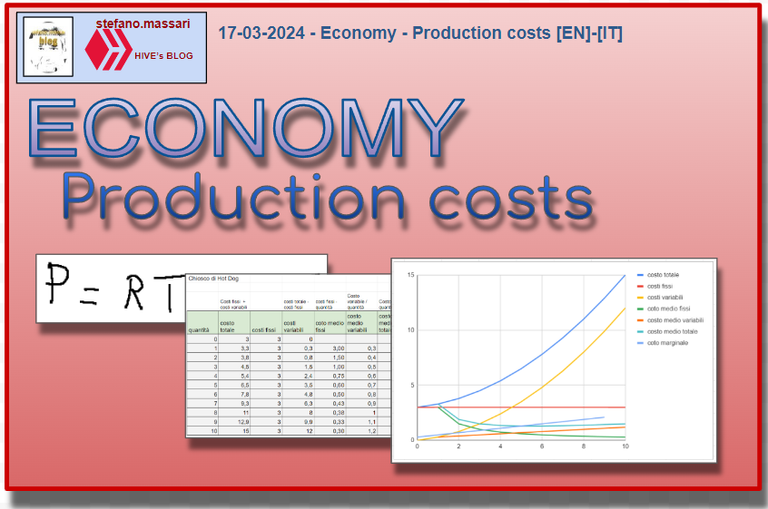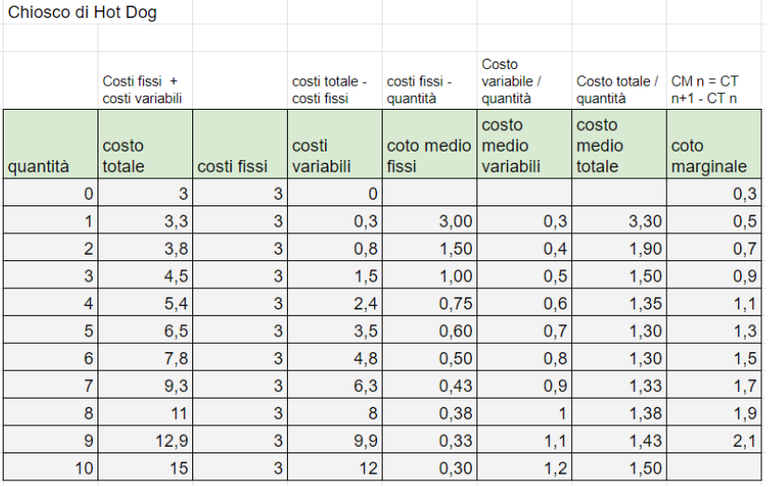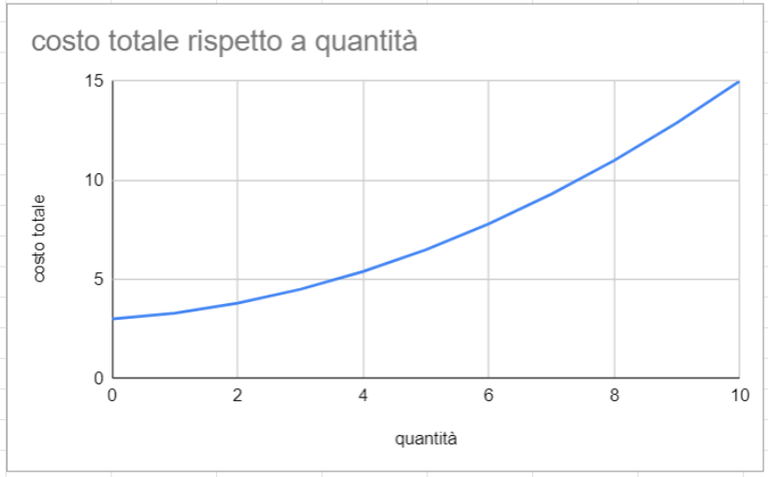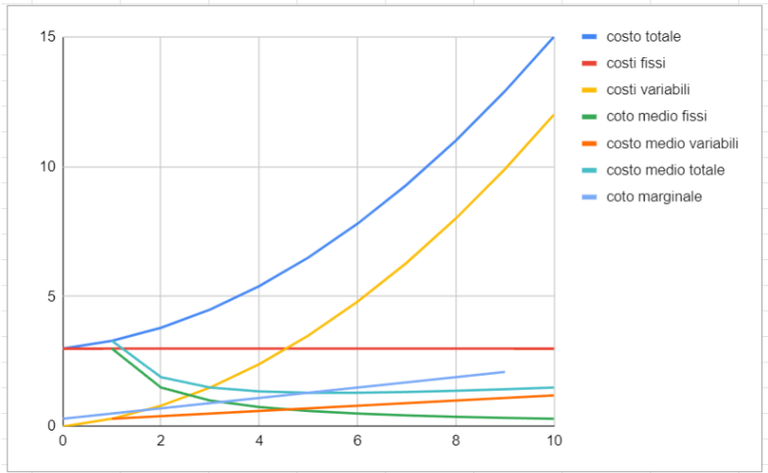17-03-2024 - Economy - Production costs [EN]-[IT]

~~~ La versione in italiano inizia subito dopo la versione in inglese ~~~
ENGLISH
17-03-2024 - Economy - Production costs [EN]-[IT]
Production
First of all, let's clarify the concept of production.
Production is the set of operations that transform primary goods and resources into final goods and products. These produced goods aim to satisfy consumer demand.
Production costs are determined by several factors listed below: the structure of the company, the technology used for their production, the cost of personnel, the cost of machinery, the fixed costs, the variable costs and the cost of materials. first used.
Total revenue, total cost and profit
Profit is total revenue minus total cost

Then there are opportunity costs which are implicit costs and explicit costs
NOTE:
There is a distinction between how an economist sees the company and how an accountant sees the company. For an economist, revenue is economic profit minus the total opportunity cost, while an accountant sees revenue as economic profit minus explicit costs.
cost check
Total cost = Fixed costs + variable costs
Variable costs = total cost - fixed cost
Average fixed cost = Fixed cost - quantity
Average variable cost = Variable cost / quantity
Average total cost = Total cost / quantity
Marginal cost = the difference between the different total costs. Example, the marginal cost of quantity 1 will be the difference of the total cost of quantity 2 minus the total cost of quantity 1.
Described mathematically it would be like this:
CM 1 = CT2 - CT1 or CM n = CT n+1 - CT n
NOTE: Marginal cost is the cost that is added if you increase production.
Below is an example of a cost table

Business cost curves
Total cost versus quantity curve

Graph where on the abscissas there is the quantity, while on the ordinates we have:
Total cost, fixed costs, variable costs, average fixed cost, average variable cost, average total cost, marginal cost

Note that:
- fixed costs are a straight line parallel to the abscissae
- the average total cost decreases between quantities 5 and 6, then outside this range it increases
- Marginal cost rises steadily
Short and long term
Costs are variable in the short and long term, so we can say that what we analyze in the short term will not be the same as what will happen in the long term and vice versa.
It must also be taken into account that initially a company can take advantage of the economy of scale, but this may not be the case in the long term.
Conclusions
The studies carried out on cost curves help the company to understand which area is where profits are highest and which area is where costs are lowest.
Request
Have you ever seen the curves relating to the average variable costs or marginal costs of a company?

ITALIAN
17-03-2024 - Economia - I costi di produzione [EN]-[IT]
Produzione
Prima di tutto chiariamo il concetto di produzione.
La produzione è l’insieme delle operazioni che trasformano beni e risorse primarie in beni e prodotti finali. Questi beni prodotti hanno l’obiettivo di soddisfare la domanda dei consumatori.
I costi di produzione sono determinati da diversi fattori elencati qui di seguito: dalla struttura dell’azienda, dalla tecnologia usata per la loro produzione, dal costo del personale, dal costo dei macchinari, dai costi fissi, dai costi variabili e dal costo delle materie prime utilizzate.
Ricavo totale, costo totale e profitto
Il profitto è il ricavo totale meno il costo totale

Esistono poi i costi opportunità che sono i costi impliciti ed i costi espliciti
NOTA:
C’è una distinzione tra come un economista vede l’impresa e come un contabile vede l'impresa. Per un economista il ricavo è il profitto economico meno il totale del costo opportunità, mentre un contabile vede il ricavo come il profitto economico meno i costi espliciti
controllo costi
Costo totale = Costi fissi + costi variabili
Costi variabili = costo totale - costo fisso
Costo medio fisso = Costo fissi - quantità
Costo medio variabile = Costo variabile / quantità
Costo medio totale = Costo totale / quantità
Costo marginale = la differenza che c’è tra i diversi costi totali. Esempio, il costo marginale della quantità 1 sarà la differenza del costo totale della quantità 2 meno il costo totale della quantità 1.
Descritto matematicamente sarebbe così:
CM 1 = CT2 - CT1 oppure CM n = CT n+1 - CT n
NOTA: Il costo marginale è il costo che si viene ad aggiungere se si aumenta la produzione.
Qui di seguito un esempio di tabella dei costi

Curve di costo delle ‘imprese
Curva del costo totale rispetto alla quantità

Grafico dove sulle ascisse c’è la quantità, mentre sulle ordinate abbiamo:
Costo totale, costi fissi, costi variabili, costo medio fissi, costo medio variabili, costo medio totale, costo marginale

Da notare che:
- i costi fissi sono una retta parallela alle ascisse
- il costo medio totale si abbassa tra le quantità 5 e 6, poi fuori da questo range si alza
- Il costo marginale si alza in maniera costante
Breve e lungo periodo
I costi sono variabili nel breve e nel lungo periodo, quindi possiamo dire che ciò che analizziamo sul breve periodo non sarà uguale a quello che avverrà nel lungo periodo e viceversa.
Bisogna tenere conto anche che inizialmente un’impresa può approfittare dell’economia di scala, ma questo potrebbe non essere così nel lungo periodo.
Conclusioni
Gli studi fatti sulle curve di costo servono all'impresa per capire qual è la zona in cui i profitti sono più alti e la zona in cui i costi sono più contenuti.
Domanda
Avete mai visto le curve relative ai cosi medi variabili o dei costi marginali di un'impresa?
THE END
What about production in the sense of doing something that produces profit, does this apply to that too? For example, engagement on hive?
Hello and thanks for being here! I admit that I hadn't thought about this. Excellent observation. In this case the cost we will have on HIVE is only the cost that we attribute to our hours. If we think that blogging for 1 hour costs us nothing, we can say that we will only make some profit.
The production cost I guess is related to the supply and demand concept also in ecinom
HI @precab You said it right, that's exactly how it is.
One interesting thing about this article in my opinion is the following.
Production costs absolutely have a mathematical aspect, so they can be translated with numbers that will give us important information on which strategy to adopt to best manage the company.
The equilibrium curve and charts are those things I was always having difficulty with when I was in high school
Thanks for the class
Thanks for stopping by. One interesting thing about this article in my opinion is the following.
Production costs are determined by: The company organisation, The company structure, The technology, The cost of personnel, The cost of machinery
Wow I so much understand this with simplicity. Thank you so much for making it simple to actually understand
Thanks for being present. These concepts are very important and perhaps as you say, for some of us these concepts are understandable. One of the things I think is important regarding production costs is the following. Since in the long run even costs that are fixed in the short run are variable, the short-run average total cost curves differ from the long-run average cost curve.
Se li ho visti, questo argomento è essenziale per vedere i vantaggi per l’azienda
Fantastico @lupega !! Mi fa piace che tu abbia visto i costi di qualche prodotto, intendo la struttura che poi definisce il costo totale. Qui di seguito riassumo le diverse misure di costo che vengono utilizzate per i calcoli.
Costi fissi (CF)
costi variabili (CV)
Costo medio (CM)
costo marginale (C’)
Costo medio totale (CMT)
Costo medio variabile (CMV)
Costo medio fisso (CMF)
Costo totale (CT)